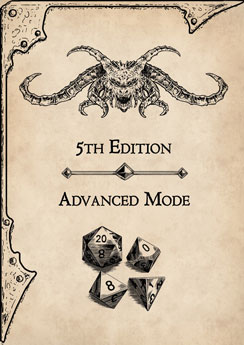Medium beast (giant animal), unaligned
Large beast (giant animal), unaligned
Armor Class 15 (Natural Armor)
Armor Class (suggested) 15 (front), 17 (flanks), 14 (rear)
Hit Points 13 (3d8)
Hit Points (suggested)16 (3d10)
Speed 30 ft., swim 30 ft.
Proficiency Bonus +2
Proficiency Bonus +2 (5th Edition Advanced Mode)
| STR | DEX | CON | INT | WIS | CHA |
|---|---|---|---|---|---|
| 13 (+1) 16 (+3)* | 15 (+2) | 11 (+0) | 1 (-5) | 9 (-1) | 3 (-4) |
Skills Stealth +4
Senses Blindsight 30 ft., passive Perception 9
Challenge 1/8 (25 XP)
Amphibious. The crab can breathe air and water.
ACTIONS
- Multiattacks (suggested). The giant crab makes two attacks with its claws.
Claw. Melee Weapon Attack: +3 to hit, reach 5 ft., one target. Hit: 4 (1d6 + 1) bludgeoning damage. The target is grappled (escape dc 11) The crab has two claws, each of which can grapple only one target
Claw (suggested). Melee Weapon Attack: +5 to hit, reach 10 ft., one target. Hit: 8 (2d4 + 3) bludgeoning/piercing damage. The target is grappled (escape DC 13). The crab has two claws, each of which can grapple only one target. The giant crab automatically inflicts 8 (2d4+3) bludgeoning/piercing damage on a grappled target.
5th Edition Advanced Mode
Limiting the power of a character and making the overall difficulty of the game harder, does not reduce the creativity, indeed it does quite the opposite.
The Game Master has the option to use any and all of the instances proposed in this guide, or just some of them according to their preference.
It is the lack of something that move and motivate characters, not the abundance of it
DESCRIPTION
The giant crab is a fearsome creature that resembles a normal crab, but with a colossal size. Its shell can span up to 10 feet across, and its weight can exceed 500 pounds. Its coloration varies from red to brown to gray, depending on its habitat and diet. Its eyes are mounted on stalks that protrude from its head, giving it a wide range of vision. Its powerful pincers can crush bones and shells with ease.
COMBAT
The giant crab is a voracious predator that hunts by stealth and surprise. It can move sideways at a fast speed, both on land and in water. It can also burrow into the sand and wait for unsuspecting prey to pass by. When it attacks, it tries to grab its target with its pincers and tear it apart. A single hit from its pincers can inflict 1d6+1 points of damage. The giant crab does not hesitate to eat anything that is edible, including carrion, fish, birds, and even humans. Once it has captured its food, it usually retreats to a safe place to devour it, unless it is threatened by a stronger foe.
HABITAT / SOCIETY
The giant crab lives along the coastlines of warm and temperate regions, where it can find plenty of food sources. It can breathe both air and water, making it adaptable to different environments. It often scavenges on dead fish and other animals that wash up on the shore, but it also hunts for live prey in the water and on the land. It is most active during dawn and dusk, when it emerges from its burrow to feed. Sometimes, it also ventures out during the day or night, depending on the availability of food.
The giant crab has no social structure or intelligence beyond its basic instincts. It mates in the fall, when the males compete for the females. The females lay their eggs in the sand, where they hatch in the spring. Only a few of the hatchlings survive to adulthood, as they face many predators and dangers.
ECOLOGY
The giant crab plays an important role in the ecosystem by cleaning up the seashores of rotting carcasses that would otherwise pollute the water and attract diseases. It also serves as a food source for some creatures, such as sharks, sea lions, and humans. Its meat is considered a delicacy by some cultures, and its shell is valued for making armor and shields. The giant crab is not endangered, as it reproduces quickly and adapts well to changing conditions.
